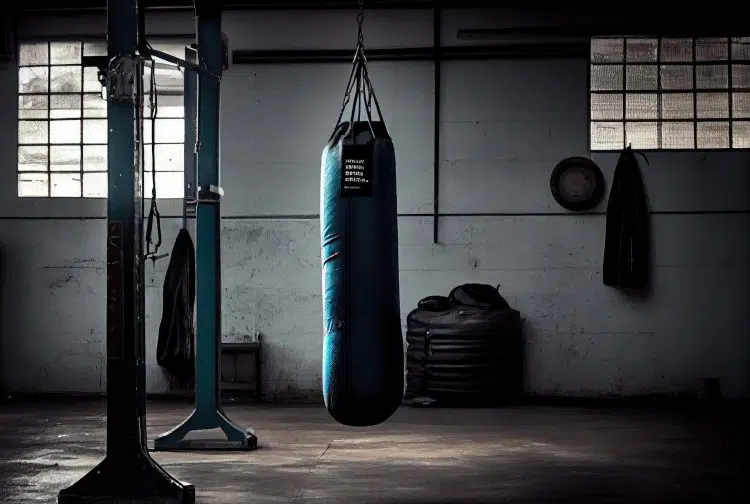Are you a current or aspiring kickboxer looking to move your workouts out of the gym and into the comfort of your own home? Well, you have landed in the right spot on this corner of the internet.
Kickboxing combines many aspects of fitness into one great fitness methodology, such as aerobic fitness, stress relief, and self-defense, to unlock a healthier and more confident version of yourself.
Over the last decade working as a strength & conditioning coach and now performance physical therapist, I am excited to draw on my experiences in health and fitness to help you craft the ultimate at-home kickboxing plan to reach your goals.
Setting up a space inside your home to tackle your kickboxing workouts will help you increase your consistency and save precious time throughout the week. Allowing you to minimize the barriers to your success and elevate your training.
This comprehensive article will dive into everything you need to know regarding kickboxing workouts. From setting up your home workout space to fundamental techniques that you should be familiar with and professional tips for optimizing your workouts.
I’ll also provide sample kickboxing workouts that blend the fundamental techniques with traditional fitness movements.
Level Up Your Fitness: Join our 💪 strong community in Fitness Volt Newsletter. Get daily inspiration, expert-backed workouts, nutrition tips, the latest in strength sports, and the support you need to reach your goals. Subscribe for free!
Now, let’s get to it!
Benefits of Kickboxing Workouts at Home
The most significant benefit to kickboxing at home is the time you save commuting to a gym. Let’s say you take an hour-long kickboxing class at a local gym that is 15 minutes away.
That same hour-long class immediately turns into an hour and a half with travel on top of any time you may spend conversing with other gym members.
For argument’s sake, conversing takes another 10 minutes post-workout. That is another forty minutes you have added to the day’s workout. Over your five to seven workout days, 4.5+ hours per week, dedicated to your workout, not training.
It is no wonder that so many people struggle to keep consistent with their workouts, as that is valuable time that could be spent doing other tasks throughout your week.
You will also avoid crowded gym spaces and waiting for equipment by choosing to train at home. It also prevents the need for a plethora of equipment or other people who need to be made aware of proper gym etiquette and maximizes the privacy of your fitness routine.
Setting Up Your Home Kickboxing Gym
Setting up your home gym for kickboxing is very straightforward. You can get started without spending a dollar on any fitness equipment. Then, after building up your fitness, you can purchase various items to enhance your workout.
The first step is to designate the actual space in your home. Look for an obstacle-free area with enough square footage and ceiling height to account for various punches, kicks, and other fitness movements.
Many of the most common household items can be turned into accessories, such as water bottles for a makeshift weight and couches or chairs for lunges and push-ups. Getting creative with the objects in your house can get you going cost-effectively.
You can pick up more traditional fitness equipment if you’re ready to take the next step in your kickboxing workouts. These include dumbbells for resistance, jump ropes for cardiovascular training variety, and striking pads to simulate a combat experience. These are just a few, but remember they are optional and are not an exhaustive list.
As an additional but necessary note, ensuring your workout space is clear of any risk of tripping, slipping, or unintentional contact with walls or furniture is critical. Make sure you take time to clear out any clutter to operate in a safe environment, and consider using matting to avoid slippery surfaces.
Level Up Your Fitness: Join our 💪 strong community in Fitness Volt Newsletter. Get daily inspiration, expert-backed workouts, nutrition tips, the latest in strength sports, and the support you need to reach your goals. Subscribe for free!
Fundamental Kickboxing Techniques
Once you have set up your space for your kickboxing workouts, review the fundamental movements you will train, including various punches and kicks.
Punches:
- Jab: In a swift motion, your lead hand extends outwards as the shoulder remains relaxed, and the arm retracts quickly to produce a rapid strike.
- Cross: While generating power from the hips and rotating your torso, the rear hand comes up and across your body.
- Hook: While rotating towards the rear arm and maintaining a bent elbow, the front arm comes across the body as you pivot on the front foot.
- Uppercut: As the body ascends from a lowered position, the rear hand rises, vertically maintaining a bent elbow.
Although the striking is with the arms in punches, the legs are essential for optimal stance width, footwork, and body mechanics to amplify the impact of each punch.
Kicks:
- Front Kick: Using the lead leg, bring the knee up towards your body and forcefully extend the knee to push the foot away from you to strike forward.
- Roundhouse Kick: While you pivot on your lead foot, swing the rear leg horizontally across your body.
- Side Kick: Shift your weight over the stance leg and tilt your torso away from the direction of your strike. Lift your knee towards your trunk and then forcefully extend the leg away laterally.
Kicks can be challenging for various reasons, including mobility, core strength, balance, coordination, etc. Emphasize controlled motions, beginning with more basic kicks in isolation and advancing to more advanced kicks in combinations.
Sample Kickboxing Workouts At Home
As with any training plan, your workouts should be catered to your experience and fitness level.
The workouts below give you a powerful fitness stimulus based on your conditioning and kickboxing prowess. You can also copy these models as you create new versions to keep your training fun and engaging.
Beginner’s Kickboxing Workout:
Warm-Up:
- Jumping jacks: 2 minutes
- Arm circles: 1-minute
- Dynamic lunges: 2 sets of 10 on each leg
Workout:
- Circuit 1 (5 Sets; alternate movements):
- Jab-cross combination: 30 seconds
- Front kicks: 30 seconds
- Rest: 1-minute
- Circuit 2 (5 Sets; alternate movements):
- Shadowboxing: 30 seconds
- Bodyweight squats: 3 seconds
- Rest: 1-minute
Cool-Down:
- Upper Body Static stretches: 5 minutes
Intermediate Kickboxing Workout:
Warm-Up:
- Jump rope: 5 minutes
- High knees: 2 minutes
- Plank: 2 sets of 30 seconds
Workout:
- Circuit 1 (5 Sets; alternate movements):
- Jab-cross-hook combination: 45 seconds
- Roundhouse kicks: 12 each leg
- Rest: 1-minute
- Circuit 2 (3 Sets; alternate movements):
- Alternating Jabs with hand weights: 20 reps
- Burpees: 10 reps
- Rest: 1-minute
Cool-Down:
- Lower Body Static Stretches: 5 minutes
Advanced Kickboxing Workout:
Warm-Up:
- Mountain Climbers: 40 seconds
- Butt Kicks: 3 sets of 15
- Inch Worms: 3 sets of 5
Workout:
- Circuit 1 (4 sets; alternate movements)
- Jab-Cross-Sidekick combo: 1-minute
- Plyometric jump squats: 15 reps
- Rest: 1-minute
- Circuit 2 (5 sets; alternate movements)
- Jab-Jab-Cross-Upper Cut: 2 minutes
- Medicine ball slams: 15 reps
- Rest: 1-minute
Cool-Down:
- Static Stretches: 5 minutes
You can modify these workouts as needed to suit your abilities by adjusting the number of sets, repetitions, adding load, or increasing speed. You can use your creativity, but remember to warm up and cool down properly and prioritize safe training.
Pro Tips For At-Home Kickboxing Success
If you want to fast-track the fitness gains from your kickboxing workouts, then make sure to adhere to these pro tips.
Prioritize Form Over Speed
Your best chance to stay injury-free is to prioritize your form and develop your movement patterns over speed (1). Moving too fast too soon can increase the likelihood of improper positioning as you perform the combinations. As you become more proficient as a kickboxer, your speed and rhythm will naturally increase, so don’t rush.
Stay Hydrated During Your Workout
Maintaining your hydration levels in your workout can help you push harder and increase your performance (2). This approach also helps prevent overheating and the need to slow down or take breaks, which can reduce the calories you burn.
Track Your Progress
The best way to stay motivated for your workouts is to track your progress to see the fruits of your labor. Regardless of your initial reason for starting kickboxing—be it reducing body fat, boosting endurance, or improving health markers—it’s important to track your progress.
Don’t Skip Your Warm-Up or Cool-Down
It is tempting to skip the warm-up or cool-down portions of your workouts. However, this is a critical mistake as a proper warm-up can reduce injury risk, improve your performance during training, and loosen stiff joints (3). A cool-down can help lower your heart rate and promote parasympathetic tone to kickstart recovery.
Don’t Forget To Make It Fun
You might start working out to change your body and lifestyle, but the joy it brings will keep you committed. So, feel free to experiment with new combos and workout styles and add some variety to your workouts to keep things exciting.
Create an energizing playlist, turn up the volume, and partner with someone to boost motivation and foster a sense of healthy competition.
Final Thoughts
Kickboxing workouts at home can help kickstart or optimize your workout routine. There are many benefits to kickboxing workouts at home, including saving time throughout the week and maintaining your privacy as you throwdown and get to training.
Whatever your fitness level, give these workouts a shot, and feel free to modify them as needed. Take the first step today by setting up your workout space and picking up some equipment.
If not, the best thing you can do is start and watch your momentum build. If you need help getting things going, I am here to help; reach out, and we’ll get things started!
References:
- Pichardo, A. W., Oliver, J. L., Harrison, C. B., Maulder, P. S., Lloyd, R. S., & Kandoi, R. (2021). Effects of Combined Resistance Training and Weightlifting on Injury Risk Factors and Resistance Training Skill of Adolescent Males. Journal of strength and conditioning research, 35(12), 3370–3377. https://doi.org/10.1519/JSC.0000000000003341
- Belval, L. N., Hosokawa, Y., Casa, D. J., Adams, W. M., Armstrong, L. E., Baker, L. B., Burke, L., Cheuvront, S., Chiampas, G., González-Alonso, J., Huggins, R. A., Kavouras, S. A., Lee, E. C., McDermott, B. P., Miller, K., Schlader, Z., Sims, S., Stearns, R. L., Troyanos, C., & Wingo, J. (2019). Practical Hydration Solutions for Sports. Nutrients, 11(7), 1550. https://doi.org/10.3390/nu11071550
- Woods, K., Bishop, P., & Jones, E. (2007). Warm-up and stretching in the prevention of muscular injury. Sports medicine (Auckland, N.Z.), 37(12), 1089–1099. https://doi.org/10.2165/00007256-200737120-00006













